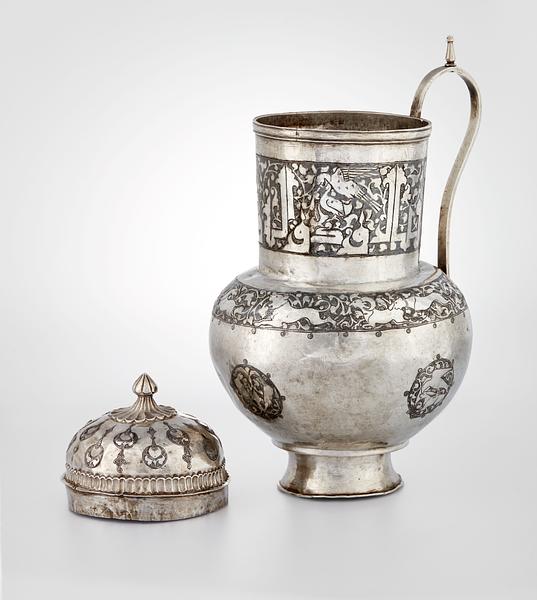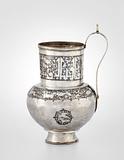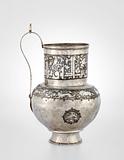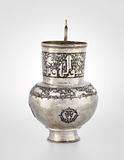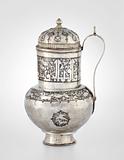Lidded jug. Silver, embossed, engraved, and inlaid with niello
Northern Iran or Central Asia; 1st half of 12th century
H with lid: 24.8; H without lid: 19.2; Diam at rim: 8.8; Greatest diam: 14 cm.
Very few large objects of gold and silver have been preserved from the Islamic world before c. 1500. This is due somewhat to the fact that Muslims were not buried with gifts. When works of art made of precious metals were outmoded, they were often melted down. The objects that are found today were generally buried in times of unrest.
This jug was decorated in three bands. At the top, on the cylindrical neck, is a Kufic Arabic inscription that appears monumental against a vine scroll that holds various birds as well as a bird of prey attacking a duck. The inscription reads:’izz wa-iqbal wa-dawla wa-sa’ada wa-’uluww – Glory, and prosperity, and fortune, and felicity, and grandeur.
At the top of the almost spherical body are animals that are hunting or being hunted, all but one of which are running from right to left, like the inscription: antelopes or wild donkeys, a mouflon, a fox, several lion-like predators, and two dogs, one of which wears a collar.
Engraved just under the animal frieze are three medallions with distinctive “curls” along the edges. Two contain birds of prey attacking hares, and the one in the center has two parakeets with their backs turned – all against vine scrolls. The handle was attached to the body where a fourth medallion could have been placed. The lid was engraved with 14 “pendants” as well as a sculptural frieze at the bottom and the top, where it ends in a knob that is mirrored slightly by the ornament at the top of the handle.
The jug’s inscription, engraved animals, and plant ornamentation appear shiny against the black, niello-inlaid contour and convoluted background. The jug was probably made under the Seljuk dynasty. The body and lid differ a bit esthetically, while the composition of the niello and silver is very uniform, as are the traces of ageing. The lid was clearly made for the jug, but possibly slightly later.
Inv. no. 36/2017
Published in:
Joachim Meyer, Rasmus Bech Olsen and Peter Wandel: Beyond words: calligraphy from the World of Islam, The David Collection, Copenhagen 2024, cat. 56, pp. 196-197;
